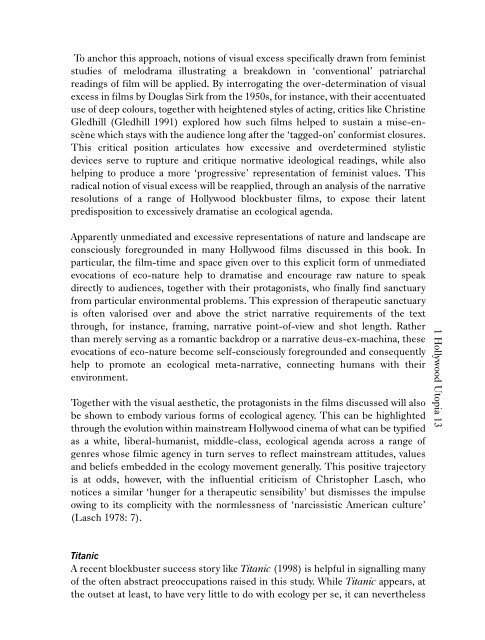Hollywood Utopia
Hollywood Utopia
Hollywood Utopia
You also want an ePaper? Increase the reach of your titles
YUMPU automatically turns print PDFs into web optimized ePapers that Google loves.
To anchor this approach, notions of visual excess specifically drawn from feminist<br />
studies of melodrama illustrating a breakdown in ‘conventional’ patriarchal<br />
readings of film will be applied. By interrogating the over-determination of visual<br />
excess in films by Douglas Sirk from the 1950s, for instance, with their accentuated<br />
use of deep colours, together with heightened styles of acting, critics like Christine<br />
Gledhill (Gledhill 1991) explored how such films helped to sustain a mise-enscène<br />
which stays with the audience long after the ‘tagged-on’ conformist closures.<br />
This critical position articulates how excessive and overdetermined stylistic<br />
devices serve to rupture and critique normative ideological readings, while also<br />
helping to produce a more ‘progressive’ representation of feminist values. This<br />
radical notion of visual excess will be reapplied, through an analysis of the narrative<br />
resolutions of a range of <strong>Hollywood</strong> blockbuster films, to expose their latent<br />
predisposition to excessively dramatise an ecological agenda.<br />
Apparently unmediated and excessive representations of nature and landscape are<br />
consciously foregrounded in many <strong>Hollywood</strong> films discussed in this book. In<br />
particular, the film-time and space given over to this explicit form of unmediated<br />
evocations of eco-nature help to dramatise and encourage raw nature to speak<br />
directly to audiences, together with their protagonists, who finally find sanctuary<br />
from particular environmental problems. This expression of therapeutic sanctuary<br />
is often valorised over and above the strict narrative requirements of the text<br />
through, for instance, framing, narrative point-of-view and shot length. Rather<br />
than merely serving as a romantic backdrop or a narrative deus-ex-machina, these<br />
evocations of eco-nature become self-consciously foregrounded and consequently<br />
help to promote an ecological meta-narrative, connecting humans with their<br />
environment.<br />
Together with the visual aesthetic, the protagonists in the films discussed will also<br />
be shown to embody various forms of ecological agency. This can be highlighted<br />
through the evolution within mainstream <strong>Hollywood</strong> cinema of what can be typified<br />
as a white, liberal-humanist, middle-class, ecological agenda across a range of<br />
genres whose filmic agency in turn serves to reflect mainstream attitudes, values<br />
and beliefs embedded in the ecology movement generally. This positive trajectory<br />
is at odds, however, with the influential criticism of Christopher Lasch, who<br />
notices a similar ‘hunger for a therapeutic sensibility’ but dismisses the impulse<br />
owing to its complicity with the normlessness of ‘narcissistic American culture’<br />
(Lasch 1978: 7).<br />
Titanic<br />
A recent blockbuster success story like Titanic (1998) is helpful in signalling many<br />
of the often abstract preoccupations raised in this study. While Titanic appears, at<br />
the outset at least, to have very little to do with ecology per se, it can nevertheless<br />
1 <strong>Hollywood</strong> <strong>Utopia</strong> 13
















